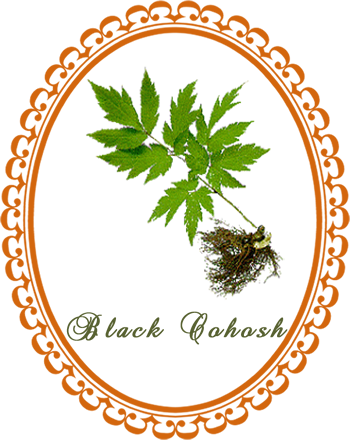
Black Cohosh: best known these days as the "menopause plant," black cohosh has become increasingly popular as a dietary supplement for reducing symptoms related with menopause, including hot flashes, irritability, mood swings, anxiety, and sleep disturbances...
Common Names: Black Cohosh, black snakeroot, bugbane, bugwort
Botanical Name: Cimicifuga racemosa
Family: Ranunculaceae
Plant Type: Perennial
Parts Used: Roots, rhizome
Flowering: May to August
Black cohosh is a member of the buttercup family, native to eastern North America. It has a range that extends from Maine to Ontario and from Wisconsin south to Missouri and Georgia. It grows in moist woodlands, typically in deep shade. Black cohosh has many different names, for example black snakeroot, bugbane and rattleweed. This herb also has a long history of use as a medicinal herb and is used in various herbal remedies. Most black cohosh is harvested in the wild.
Description: Black cohosh is a robust perennial that forms clumps four to seven feet in height. The leaves are divided into threes, with three-lobed terminal leaflets. Around midsummer, black cohosh sends up tall spires of feathery white flowers. It has a knobby, black root (rhizome) that emits a slightly resinous scent.
Cultivation: Find a shady area with damp soil for your black cohosh seeds. This plant prefers humus rich soil, the kind you find in the mossy beds of a forest. Plant seeds ¼ inch below the soil in a flat in late summer, spaced about 2 feet apart. Once you've planted the seeds, cover the soil with mulch to keep in moisture. Seeds will need 2-4 weeks of warm temperatures, around 70F, followed by at least 3 months of cold, about 40F. In many locations, the ripe seeds can be planted in a shady bed in late summer or early fall and left for 18 months or so. Transplant the seedlings into individual pots once they pop up with their second set of true leaves, the ones that come up after the "seed leaves" appear. Leave them in a shady area for another 6 months and in late summer or early fall, when the plants are about two years old, you can plant them in a shady garden. Black cohosh has a rather unpleasant smell to humans, but bees and birds love it.
Harvesting: Get ready for harvest as you watch the seedlings develop in little capsules from August to October. The capsules will rattle when shaken. Harvest black cohosh sometime in October. The rhizome will be dark brown to black in color, thick and gnarled. The roots attached to the rhizome are used for medicinal purposes. Wash the roots, blot with a paper towel and dry on a wire rack in a clean, well-ventilated area at 80F to 95F for one week. Once they are dry, store them in a burlap bag or cardboard drum in a cool, dark, dry location. Use within a year.
Black Cohosh Magick
Love. Courage. Protection. Potency.
Gender: Masculine
Carry a piece of black cohosh to strengthen your courage.
Sprinkle an infusion of black cohosh around a room or add to the bath to drive away evil spirits.
Herbal Healing with Black Cohosh
Medicinal Actions: Antibacterial, antifungal, antipyretic, diaphoretic
Medicinal Uses: Black cohosh is currently used to treat the symptoms of menopause such as hot flashes, night sweats and other symptoms. In North America, it is thought that the herb balances estrogen by stabilizing it. In European herbalism, it is thought to have an estrogenic action, which actively works to reduce progesterone and promote estrogen levels in the body. It is therefore used where there is a lack of estrogen and an excess of progesterone. It has long been used to regulate the menstrual cycle and to treat premenstrual syndrome. Black cohosh has been used to treat other abnormalities in the female reproductive system like inflammation of the ovaries and uterus, infertility, threatened miscarriage and to give pain relief in labor. It has also been a traditional remedy to induce labor in pregnant women.
In the musculoskeletal system, this herb has been used to treat rheumatism, arthritis and other muscle pain. This herb has been used for hives, colds, coughs, constipation, backache and to aid lactation.
Herbal Combinations: Black cohosh is frequently paired with blue cohosh to use in alternating doses to induce labor at the end of pregnancy. This should only be attempted under the guidance of an experienced care giver. It is also combined with bogbean as a treatment for rheumatism.
Cautions: Black cohosh has an estrogen-like effect, and women who are pregnant or lactating should not use the herb. Women taking estrogen therapy should consult a physician before using black cohosh. There is also concern that women with a history of breast cancer in the family should not take cohosh.
Do not use black cohosh where there is low blood pressure.
Large doses of this herb may cause abdominal pain, nausea, headaches, and dizziness.
Preparation and Dosage: This remedy is quite strong, and as such care must be taken not to exceed the stated limits. Black cohosh is usually taken from commercial preparations. Due to a variance in active compounds depending on the manufacturer, it is very important to follow the dosage instructions on the label very carefully. The typical dose for adults ranges from 40 to 80 mg of per day. For a tincture, that translates to 2 to 4 ml, to be taken three times per day diluted in tea or water. Black cohosh can be taken for up to six months, and then it should be discontinued.
If you appreciate the information provided,
please help keep this website running. Blessings!
© 2008-2022 aromaworx.ca. All rights reserved.

